North Karnataka Trip - I
Journey to Hospet
I didn’t have much expectations regarding the KSTDC tour package. I had earlier talked to one of my colleagues who had gone for a 1-day tour conducted by KSTDC to Shravanabelagola, Belur and Halebid. He had told me that the KSTDC people would take us to the places on their bus, and ask us to go and see around and come back to the bus within short time. That way, they squeeze more number of places to the package, which would look attractive to the people; But actually we will end up feeling as if we just saw a collection of photographs from the places.
Our package was also not different - They have eight places included in it: Tungabhadra Dam, Hampi, Banashankari, Badami, Pattadakal, Aihole, Bijapur and Kudala Samgama. They call it a 5-day trip, but it is effectively only a three day tour, as we start from Bangalore on Thursday night, and reach back here on Monday morning. The travel, accommodation and tourist guide charges are included in the package (Rs. 1650 per person), and the rest have to borne by us.
We started from home on Thursday (November 3) 7:30PM. Deepavali celebrations were still going on and I was a bit scared that a cracker would fall on us any point of time while walking through the roads. We got an auto-rickshaw from Nanjappa Circle and got down at Corporation Circle. The KSTDC office, called Badami House, is near the circle. We reported at the reception office and they told us that the bus would reach at 9. There were several people waiting there for their buses, and it looked like KSTDC tours were very popular. Achchan was anxious that we won’t be able to see much at Hampi, as there would be a big crowd there, owing to the annual cultural festival called Hampi Utsav that is held there every year during November first week.
Our bus reached Badami House at sharp 9. That bus was to be our home for the next three days. We boarded the bus and found that it was a decent one, with enough space between the chairs to stretch our legs, etc. At 9:30PM, the guide Mr. Iyer, employed by KSTDC, came into the bus and introduced himself. He gave a brief overview of the itinerary and then the bus started.
The bus halted at Kamat Upachar hotel on the way near Tumkur for dinner. I remembered taking meals from there during an earlier trip to Dandeli with my colleagues. This time, we had brought some vegetable biriyani packed from home, so we had that, and went to the hotel for a tea.
Our first destination was Tungabhadra dam, which is near Hospet. I had noted in a map that a national highway runs between Bangalore and Hospet. But the state of the road was pathetic and we felt like we were going through some rough farmlands. I couldn’t get a wink of sleep. It was quite dark and I couldn’t see anything outside. At one place, there were several windmills installed on top of a hill, and the electric lights blinking on their peaks were getting reflected on their rotating blades, creating interesting patterns. From distance, I couldn’t make out what it was, and I kept on making guesses. Somewhere in the early morning of Friday, I got a bit of sleep. When I woke up, I could see the sun rising outside, and felt the cool, fresh, pleasing air coming through the windows of the bus.
Tungabhadra Dam
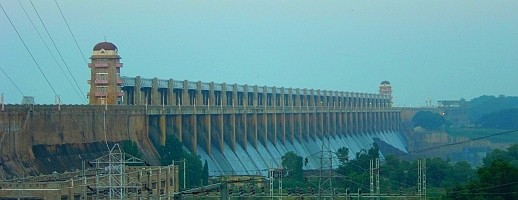
Tungabhadra dam, TB Dam as it is called, is built across river Tungabhadra, and it is just few kilometers from Hospet. The driver parked the bus near the dam and we all got outside. The time was 6:15AM and it was still pretty cold there. Our guide told us that we should go and visit the dam and then come back to the bus within an hour. We could hear bells ringing and Venkatesha Suprabhatham sung by MS Subbalakshmi coming from some distant temple.
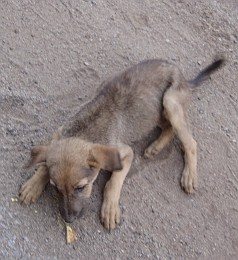 At the gate of TB Dam, we were welcomed by a puppy! It seemed as if the puppy was just expecting us, and he lead us towards the dam enthusiastically. He didn’t seem to be very healthy, and after walking for five minutes, he got tired and lied curling on the road wherever it was standing. We gave some biscuits to the dog and then walked forward.
At the gate of TB Dam, we were welcomed by a puppy! It seemed as if the puppy was just expecting us, and he lead us towards the dam enthusiastically. He didn’t seem to be very healthy, and after walking for five minutes, he got tired and lied curling on the road wherever it was standing. We gave some biscuits to the dog and then walked forward.
Visitors are not allowed to walk over the dam. We climbed to a small observatory near the dam - The view of the dam from there was amazing. I could see nothing but water in the horizon. Other than the sea, I haven’t seen any other water body before which was as vast as that. There is a model of the dam kept inside a room there, but it was covered with a tarpaulin, so we couldn’t see it. We climbed down and walked back. On the way there is a small bridge that takes us across a water canal, to a nice garden. Boards indicate that there is a musical fountain and a deer park nearby, but we didn’t have time to watch all that as the allotted time of one hour was already over.
As we walked towards our bus, near the gate we saw the puppy again, sleeping peacefully there. It didn’t seem to notice us.
Some passengers were yet to come, and the guide was becoming restless. By 7:30, all reported back, and we proceeded towards Hampi.
Mayura Bhuvaneshwari
If we have to fully appreciate the works of Kannada authors like Shreekrishna Alanahally, Kuvempu and Shivarama Karanth, we need to travel through the villages of Karnataka. Unlike the villages of Kerala, I guess the Karnataka villages might be very much as they were several decades ago, as I could see no signs of "modern" developments in the area. Vast fields of paddy, corn, wheat, sugarcane and vegetables spread to several kilometers between each country homes. Houses were of three types - Huts with palm leaves for roofing and walls, middleclass houses with un-plastered walls made of bricks and tiles roofs - they have a certain kind of open verandah covered with iron nets -, and large houses with padippura and tall haystacks in their front yards.
Our accommodation was provided at Hotel Mayura Bhuvaneshwari at Kamalapuram, near Hampi. During our journey, the bus passed through Hospet, and after sometime, we could see a vast lake on the right side of the bus, with the morning sunlight illuminating its surface. This was an artificial lake called Kamalapuram tank, dug by the Vijayanagara rulers five hundred years back, as the main source of water supply for Hampi. This tank used to feed water in various tanks inside the royal palaces, through underground canals covered with stone slabs. This amazing water supply system is almost well preserved even now, surpassing any track record of the Government of India.
Kamalapuram is a small village, and it looked like Mayura hotel was the only decent(!!) place available there for tourists to stay. This hotel is run by KSTDC and it is situated in a vast compound (since land would be pretty cheap there, probably). The hotel actually looked neat from outside. But when we opened our allotted room, we were taken aback by the stink there. I felt that the bed covers were unwashed for years, and the floor was dirty. The bathroom looked okay, fortunately, and we could get plenty of hot water from a tap outside. We brought hot water in buckets and finished our bath. There is a restaurant in the hotel and we had idli and uppittu there - That was the only thing available there.
At 10, we all got into the bus and we started towards Hampi.
Talarigatta Gate
Hampi was the capital of Vijayanagara empire for around two hundred years starting from the mid-fourteenth century. The empire saw its peek during the rule of Krishnadeva Raya, during which it extended almost to the entire South India, and Hampi gained the reputation of one of the greatest cities in the world during that time. Hampi was an ideal place for a capital, as the hilly terrains filled with thousands of huge boulders and the Tungabhadra river make the city almost impregnable. Krishnadeva Raya was a strong ruler and a great connoisseur of arts, and almost the entire city - spreading to 26 square kilometers - is filled with temples, statues and other artworks carved in stones. The city was destroyed by the Muslim rules in 1565 after the battle of Tallikota, in which Vijayanagara was defeated by the combined forces of four Muslim Sultanates. The city is now covered with ruins - any place we look at, we could see some ancient temple, mandapa or some carving on a stone.
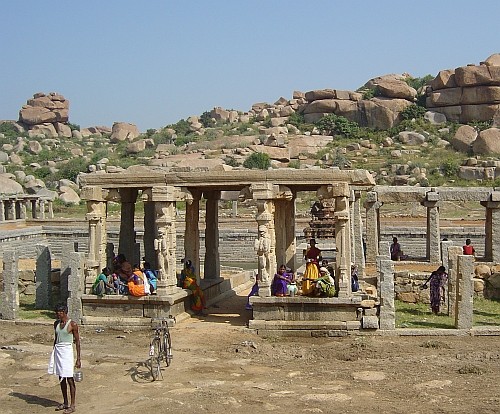
Villagers relaxing in front of the sacred tank called Lokapavani, near the Talarigatta Gate
There used to be a fort covering the royal enclosure at Hampi, and the remains of the fort are still seen. Our bus passed through a gate called Talarigatta Gate, which is an opening in the fort. The gate is too narrow, and is just wide enough for the bus to pass through. The bus proceeded further and after five minutes, we reached the ancient Vitthala Temple. This temple used to have an idol of Krishna, but presently the idol is not there and the temple is not used for worshipping. The temple was built under Devaraya II, and improved by Krishnadeva Raya and his successors. In front of every temple at Hampi, there used to be a bazaar or market, and the remains of the 945-meter long bazaar is still seen in front of the Vitthala temple. The sacred tank called Lokapavani is situated at the end of the bazaar.
Vitthala Temple
The KSTDC brochure had told that we need not pay any money to the tourist guide who accompanied us, as he is employed by KSTDC. However, our guide's role was only that of a "ticker checker" cum travel coordinator and he had "outsourced" the guide's job to local people. He collected Rs.60 from each of us towards fee to the local guides. Our guide to Hampi was a middle-aged man who spoke mainly in Kannada and occasionally in broken English. In front of each monument, he would say, "Most Important - Go and enjoy"!
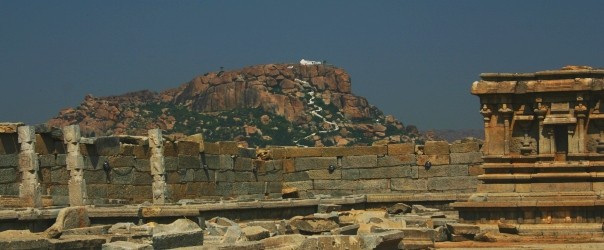
A view of Anjanadri from Vitthala temple.
Before entering Vitthala temple, our guide lead us to the back side of the temple and gave us some background regarding Hampi. From there, We could get a view of Tungabhadra flowing behind the temple, and several hills nearby. All these hills have legends associated with them, and the guide told us briefly about legends associated with Hampi. One legend says that the ancient kingdom of Kishkindha is close to Hampi, and Hampi is the place where Sugreeva fought with Bali. It seems Hanuman was born in a nearby hill called Anjanadri, named after Anjana Devi, Hanuman's mother. Hemakuta hill is associated with the legends of Shiva and Parvathi, and Malayavantha hill is the place where Rama stayed when Hanuman went to Lanka in search of Sita. Mathanga and Rishyamooka hills are also nearby and they are mentioned in the Ramayana. On top of Anjanadri, there is a temple and we could see it as a white spot on its peak. I wished to climb to it for having a view of the Hampi landscape, but I knew that it wont be possible in a packaged tour.
At some distance from Vitthala temple, we could see the ruins of a stone mandapa called Purandara Dasa mandapa. It seems this was the place where the poet sat and composed Carnatic classical music. We can also see ruins of a stone bridge near the mandapa that goes to the other side of Tungabhadra.
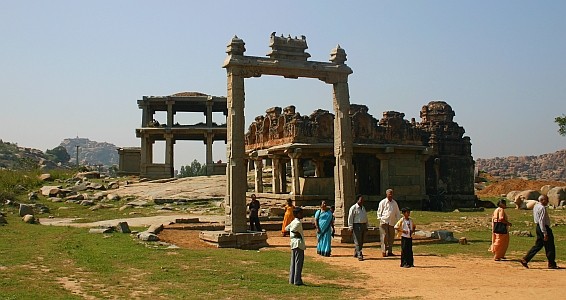
King's balance
Our guide lead us to a kind of archway called King's balance. This was the place where the Vijayanagara kings used to perform thulabhara, weighing themselves against gold and precious stones, which were later distributed to Brahmins. There are few ruined mandapams (they are seen almost everywhere) and a Jain temple near the King's balance. We spent just five minutes there and by then the guide had started making a fuss that "we don’t have discipline", etc., and he wanted us to hurry towards the Vitthala temple.

Carvings on the gopuram of Vitthala temple.
I think these were recently restored by the archeological department.
At the Vitthala temple also the story was not different. The guide wanted us to just follow him like children going behind their teacher during a school picnic, and just listen to him and see what he shows us. He even had a whistle which he blew every now and then when he noticed some of us going out of order. I was easily fed up with the guide, but we didn’t have any option but to follow him. I decided that at some point of time I should come to Hampi alone and see the places according to my wish.
The first thing that would attract a visitor in the Vitthala temple is the stone chariot. This is an intricately carved image of the wooden chariot used for temple processions, and there are only three such chariots in India, the other two being at Konark and Mahabalipuram. This chariot is not made in a single stone, but the amazing engineering work of the Vijayanagara architects makes us feel as if it is monolithic.
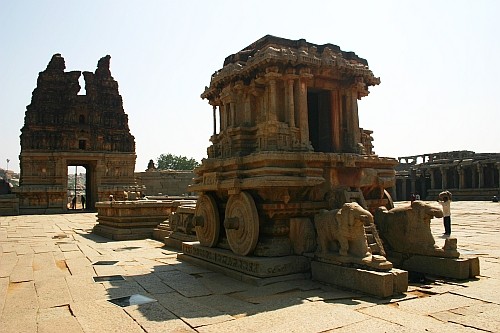
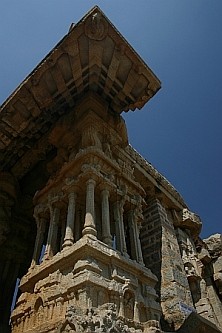
Left: Stone chariot in front of Vitthala temple. The broken front gopuram of the temple is also seen.
Right: A pillar in the sabha mandapa
Inside the temple complex, we can also see the kalyana mandapa, utsava mandapa and sabha mandapa. The sabha mandapa has several pillars carved out of single granite blocks, with several small pillars carved on it. They produce musical knots when tapped, hence the mandapa is also called swara mandapa. It seems great musicians used to sing together sitting inside this mandapa during ancient days, each facing a musical pillar, accompanied by classical dance performances, which the king used to view. There are several beautiful statues on the pillars; Unfortunately, many of them were mutilated by the Muslim invaders during 16th century.
We walked around the temple for a while and from the southern side of it, we could get a good view of distant hills and the river. The heat was intense (Bellary district, in which Hampi is located, consistently reports the highest temperature in Karnataka state, and I remember reading in the weather pages of newspapers that "Bellary is Hottest" etc. always). We were feeling thirsty already, and bought tender coconuts from a vendor nearby. Then, the guide gave us signal to get into the bus again, and we started towards Virupaksha temple. On the way back, near Talarigatta gate, the driver applied a sudden brake, and we all started looking out through the windows to find out why the bus stopped. Somebody told that a snake was lying on the road, getting stuck in the tar that melted under the sun, and it was struggling to escape it seems. Some people got down from the bus to watch the scene, but by then the snake had managed to get rid of the tar and had disappeared in the nearby scrubs.
Virupaksha Temple
Our bus took us back through the road in which we had come to Vitthala temple, and soon we reached a junction from where a road would lead us to Virupaksha temple. But, the road was blocked and police officers were standing there diverting the traffic. It seems some Government officials and ministers were coming to attend the Hampi Utsav, hence the road was closed for other vehicles. So, we had to take an alternate path. This took us in front of the Kamalapuram tank again, and a Muslim tomb and a mosque, which the secular kings of Vijayanagara had patronized, it seems. Within ten minutes, the bus reached Virupaksha temple. There was a big crowd there and several vehicles were parked there. We saw an arena set up for wrestling competitions to be held as part of the Hampi Utsav, and the guide told us that women would also participate in these competitions.
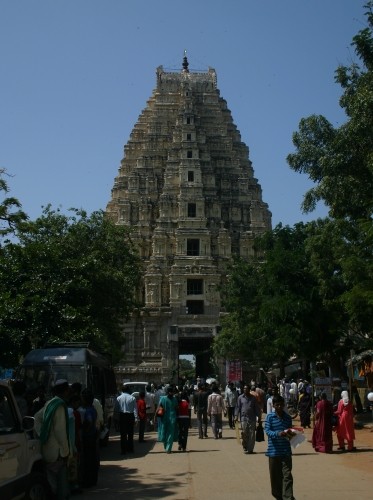 Virupaksha temple is the only temple at Hampi which is being worshipped even now. Pampapati or Virupaksha, the deity of the royal persons, is being worshipped here. It seems this is the most ancient temple in Hampi, and the first reference to the place describes it as a small shrine of the seventh century. A temple was constructed at the place and it was enhanced by various dynasties who ruled the place from that time. It later flourished under the patronage of Devaraya II and Krishnadeva Raya, who built a ranga mandapa (painted hall) in front of the sanctum sanctorum. The front tower of the temple is tall and looks magnificent.
Virupaksha temple is the only temple at Hampi which is being worshipped even now. Pampapati or Virupaksha, the deity of the royal persons, is being worshipped here. It seems this is the most ancient temple in Hampi, and the first reference to the place describes it as a small shrine of the seventh century. A temple was constructed at the place and it was enhanced by various dynasties who ruled the place from that time. It later flourished under the patronage of Devaraya II and Krishnadeva Raya, who built a ranga mandapa (painted hall) in front of the sanctum sanctorum. The front tower of the temple is tall and looks magnificent.
There was a queue inside the temple, and it took some fifteen minutes for us to get the darshana. Behind the temple, there is a place where we could see an inverted shadow (?) of the front gopuram, it seems. I couldn’t exactly figure out what it was. There was a big rush there for getting a glimpse of this, and I decided to skip this view. In the temple complex, there was a person who was making some interesting music with a peculiar instrument and asking for donations from people. I liked this music. It looked like a war-cry that is heard in the Mahabharata television serial.
We came out of Virupaksha temple and then our guide asked us to take a narrow pathway that was going up towards the Hemakuta hill, to the right of the temple. On one side of the pathway we saw a small house where it looked like the entire family was working on cleaning up a large heap of green chillies. Amma said that it might be for making bajjis and selling during the evening. I felt water coming to my mouth as chilly bajji is one of my favorite snacks. After some time, the pathway ended and then we climbed through steps carved on the hill. Soon we reached a small gopuram through which we entered a slope in the hill. There are several small temples on this slope, belonging to the Vijayanagara and pre-Vijayanagara periods. Two of them looked special with their marked difference in architecture - They had a kind of stepped roof which resembled the temples of North India.
Few meters to the east of Hemakuta hill there is a Ganesha temple (it is not being worshipped now). Inside the sanctum sanctorum, there is a nearly 5-meter tall statue of Lord Ganesha, which is called Kadale Kalu Ganesha (gram seed Ganesha). It is called so, because this idol is the bigger than a counterpart, Sasive Kalu Ganesha (mustard seed Ganesha) which is nearby. I couldn’t take good photographs of the big Ganesha because of poor lighting conditions.
We climbed down from the Hemakuta hill and reached an open space near the vehicle parking space. Some free meal was being distributed there, and the hot rice and sambar looked very inviting to us, as it was meal time and we all were hungry. We waited there for ten minutes, but we couldn’t find our tourist guide! Then he suddenly appeared from somewhere, and gave us a discourse about the importance of following discipline and timelines during conducted trips. It seems we were supposed to go Sasive Kalu Ganesha from Hemakuta hill, and he was searching for us everywhere. Anyway, we walked to the smaller, 2.4 meter Ganesha statue that was installed in a stone mandapa, and then sat under a tree there for sometime.
More Temples
Next destination was Balakrishna temple, built by Krishnadeva Raya to celebrate his victory over the king of Kalinga. It seems he brought an image of Krishna from the Kalinga country after the war and installed it in the temple. The idol is not there in the temple now, though.
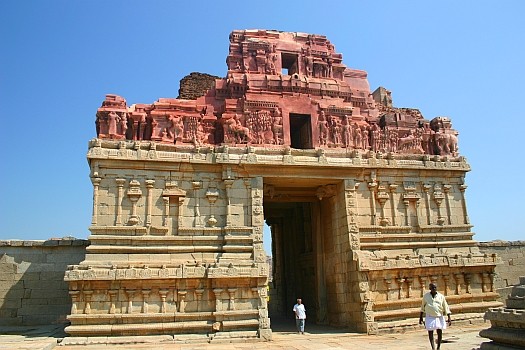
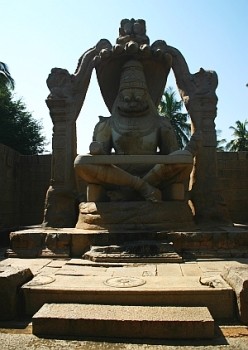
Left: Ruined gopuram of Balakrishna temple.
Right: Lakshmi Narasimha statue.
Out driver had brought the bus near the entrance of Balakrishna temple. We got into the bus and a five minute drive took us to a place where the famous Narasimha statue was situated. At this place, unlike at other monuments of Hampi, there is lot of vegetation and less of rocks. From the main road, we have to walk for a minute through an untarred pathway and then we will reach the Narasimha temple, installed by Krishnadeva Raya.
The 6.7 meter tall statue of Lakshmi Narasimha is located in a closed chamber. The massive statue is carved out of a single stone, and it is a fine example of the skills of Vijayanagara sculptors. Next to this temple, there is yet another enclosure called Badavilinga temple, where a 3-meter high Shiva Linga is installed. This idol is also carved out of a single rock, and the board in front of the temple mentions about the legend that this temple was installed by a poor woman.
Royal Enclosure
We got into the bus again, and proceeded towards the royal enclosure, inside the fort. We had got used to Hampi by then, and I felt it like a very common sight to see some ancient temple in any direction we look at. Near the royal enclosure we saw an underground temple. Our guide pointed us to it, but the bus didn’t stop there! At another place, there were two huge rocks leaning against each other - an amazing trick of Mother Nature. These rocks are called Akka Thangi Kallu (Sister Stones), our guide explained. Soon, we reached the Zanana enclosure, the residence of the queens.
This enclosure has tall walls on all four sides. Watch towers are installed at various places on the walls. It seems the King was the only male person who entered the Zanana enclosure, and the servants, attendants and people on the watchtower were all women. Inside the enclosure, there are several important buildings. The royal treasury is located at one corner. Next to it there are the basements of two palaces, for the two queens of Krishnadeva Raya. Only the basements of these palaces remain now, as they are made of granite. The palace was built mainly of wood (including sandalwood), and it was burnt during the Muslim invasion, it seems. The archeological department has maintained the Zanana enclosure well, and there is a nice lawn in front of the queen's palaces.
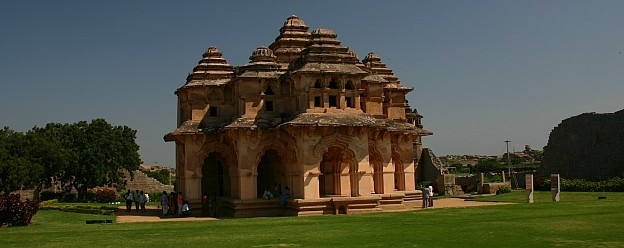
Lotus Mahal
Next to the palaces, there is a building called Lotus Mahal, which still remains intact. The king used to come and sit on top of this two-storied palace and enjoy the gentle breeze during summer. This building features a combination of Indian and Islamic architecture, with the pillars and arches constructed in Islamic style, and parts of the roofs in the style of Hindu temples. It was because of the Islamic look-and-feel that this building was left untouched by the Muslim invaders, it seems.
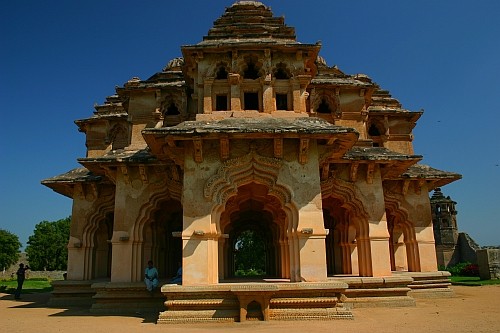
A closer view of the Lotus Mahal - Parts of the watch tower can also be seen.
The royal elephant stables and guards quarters are nearby. These buildings also show a combination of Indian and Islamic architecture. There were several plastic chairs arranged in the ground in front of the elephant stables, and electric bulbs were also installed. Our guide told that these were for the Hampi Utsav programs, which were to be conducted at several stages. He advised us to come to the elephant stables in the evening and watch the programs there.
It was 2:30PM then. Our bus took us back to the hotel for lunch. On the way, we saw the beautiful Hazara Rama temple, Queen's bath and a tall stage called Mahanavami Dibba on which the King used to sit and watch the Dasara festival. We also saw the remains of the royal palace. Just like the palaces of the queens, only the basements, made of granite, remain now. The palace building made of wood was destroyed during the invasion.
It would need at least a week to see all the monuments of Hampi, our guide told. Since our stay at Hampi was only for a day, we just had a glimpse of some of the important places, that’s all. We got down at the hotel and the guide told us that we can have our lunch and take rest till 4PM. At 4, they were to take us to Virupaksha temple again, and we were free to spend the rest of the day as we wished.
Pushkarani
Lunch at Mayura hotel was as pathetic as their rooms. My wife saw a waiter inserting his fingers inside his nose, and I discovered a fly in sambar, so both of us stopped the lunch halfway. We were back to our rooms at 3. We had around an hour with us, and I wanted to see the beautiful octagonal stepped pond called Pushkarani which has been shown in several Hindi and Tamil films.
I had earlier asked the tourist guide about Pushkarani and he had told that it is nearby. To get more details, we went towards the security guard in the hotel. Looking at the khaki trousers and shirt of this old man, somehow we got the impression that he might be knowing Hindi and English. So, we asked him where the "octagonal tank Pushkarani" was. He told us that the "tank" was on the first floor of the hotel and hot water would be available only in the mornings till 9AM. My wife got this idea that we could ask him about the pond where films are shot. The mention of the word "films" looked like giving some clue and he became enthusiastic. He told that there are theatres at Hospet. My wife was about to show him a photograph of the pond in the tourist guide and ask him where it was. I prevented her as I just wanted to escape from him; So I asked him where the "museum" was. "Oh! Mujiem!", the poor man came out with us and happily gave detailed directions to the museum (which, I had earlier learned, was at five minute walk from the hotel).
We decided to find the way ourselves, and started walking. I had a Hampi tourist map and looking at that I made a guess regarding an approximate route to the pond. We reached a junction where few police officers were standing. We asked one of us regarding the tank, and he gave us directions. On the way, we could see little children moving with heaps of grass on their head. It didn’t look like there were any schools nearby, so we guessed that the children at these places would be joining their parents' work very early in their childhood. We walked for few minutes and then saw a board showing ways to the queen's bath, Mahanavami Dibba and Pushkarani. It was in fact on the way in which we had traveled in the morning. We entered a large complex where there was a ruined temple called Chandrashekhara temple. However, we couldn’t locate the octagonal tank. An old woman was coming towards us, and we showed her the photograph of Pushkarani and asked, "elli?". She pointed her hand towards one direction and then wanted to know from where we were coming, etc. After giving her the answers, we walked further, and reached the Mahanavami Dibba - Still, no clues regarding Pushkarani.
We sat for few minutes inside the abandoned Chandrashekhara temple. There were no tourists coming to this temple, and it looked like nobody usually enters this temple. It was nearly 4, and we had to get back to the hotel. So, we sadly walked back. We were just on time at the hotel, but there was no one else in front of the bus. The driver came only at 5, and we regretted hundred times that we hurried to the hotel and missed Pushkarani.
Hampi Utsav
Hampi Utsav is the annual cultural festival organized by the Government of Karnataka. Artists from various parts of the state come to Hampi and present their programs during the festival. Our bus took us near the Virupaksha temple and the guide told us that we could go anywhere and report back at 9:30PM, when the bus would take us back to the hotel.
Going to Pushkarani was ruled out, as it had become dark. We decided to go to Virupaksha temple and watch some programs of the Hampi Utsav. Our co-passengers in the bus went in various directions, except for an old lady who joined us.
I wanted to climb to the Hemakuta hill and get a view of the sunset. But, by the time we reached its peak, sunset was already over. The view from there was brilliant, but it was becoming dark. We climbed down and walked to the Virupaksha temple. The old lady, who was walking with us, went inside the temple, but we decided to go for a walk in the Virupaksha bazaar, the marketplace in front of the temple. It was very much crowded with people who have come to watch the Utsav programs. Four hundred years back, the bazaar used to be the place where gold and rubies were sold. Now, they sell handicrafts and food items there. A series of eateries have been setup on one side of the road. They all looked like temporary arrangements, but their name boards mentioned that they are "recommended by Lonely Planet tourist guides". We had coffee from one place. In front of this restaurant, a lady was frying chilly bajjis. Amma and me were really tempted by its aroma; But I was a bit sceptical about the hygiene aspects. Then we saw people coming and buying hot bajjis directly taken from the pan and served on newspaper sheets. I couldn’t resist the temptation further, and bought four bajjis from the lady. It was delicious.
We wanted to sit in a relatively calm area, so we walked for some distance and reached near the statue of "Kadale Kalu Ganesha". There was a stage arranged there and some dance programs depicting the story of Shanthala was going on there. We climbed to a rock to get a better view of the program. A voice called us from behind. We saw an entire family - it looked like a poor one - was sitting in the darkness behind, and I think they had found that comfortable place quite early and made a temporary home around that. We moved away so that their view was not disrupted.
After some time, there was an interesting incident. A man wearing silk kurta and pajamas came straight to us and started talking to Amma in Kannada. Amma thought that probably he might be a distant relative who had migrated to Karnataka, and tried to recollect who exactly he was. By then, the man turned towards me and then started talking in English. It seems he was from All India Radio and had come to cover the Hampi Utsav program. "Tell me what you feel about this program in few words. It will be broadcast in entire Karnataka state!", he told. I told that I didn’t understand even a bit of the programs, and was not the right person to comment about Hampi Utsav. He walked to the next person.
A small rocky hill was nearby. We climbed to it and took rest for some time. It was only 8PM and we had plenty of time with us. We ate some snacks we had brought along with us and tried to fully grasp the essence of the "present moment" - A day before, we were in Bangalore, and now we are sitting on a rock under open, dark sky, at this remote village. Great many kings might have walked through the pathway in front of us, and many a war might have been fought there for this city.
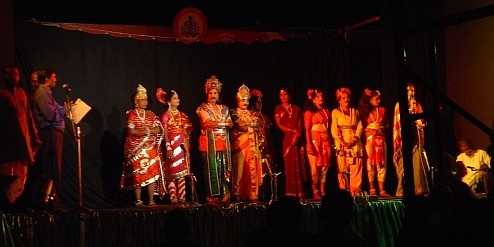
Hampi Utsav - A drama program
After some time, we decided to go back to our bus. There was a long line of vehicles on the way. Near the bus stand, some exhibition was going on and we had a look inside. Most of the stalls were targeted towards farmers. We spent some time in front of a tractor, and the man in that stall thought that we were interested in buying that. He gave us few pamphlets which Achchan received with a serious face expression, and then we walked away. A stage was setup near the bus stand also, and some ballet program was going on there. We spent few minutes watching the ballet. There were plenty of mosquitoes, and it was becoming unbearable to sit there.
At 9, we got into our bus and slept there. I was half asleep when the driver came in and started the vehicle. We reached the hotel at 10. None of us were feeling like taking dinner from Mayura hotel. We asked for tea, but they told they had no tea there. We bought a bottle of mineral water and went to our room. Even though the beds were stinking, I slept easily and peacefully.
I didn’t have much expectations regarding the KSTDC tour package. I had earlier talked to one of my colleagues who had gone for a 1-day tour conducted by KSTDC to Shravanabelagola, Belur and Halebid. He had told me that the KSTDC people would take us to the places on their bus, and ask us to go and see around and come back to the bus within short time. That way, they squeeze more number of places to the package, which would look attractive to the people; But actually we will end up feeling as if we just saw a collection of photographs from the places.
Our package was also not different - They have eight places included in it: Tungabhadra Dam, Hampi, Banashankari, Badami, Pattadakal, Aihole, Bijapur and Kudala Samgama. They call it a 5-day trip, but it is effectively only a three day tour, as we start from Bangalore on Thursday night, and reach back here on Monday morning. The travel, accommodation and tourist guide charges are included in the package (Rs. 1650 per person), and the rest have to borne by us.
We started from home on Thursday (November 3) 7:30PM. Deepavali celebrations were still going on and I was a bit scared that a cracker would fall on us any point of time while walking through the roads. We got an auto-rickshaw from Nanjappa Circle and got down at Corporation Circle. The KSTDC office, called Badami House, is near the circle. We reported at the reception office and they told us that the bus would reach at 9. There were several people waiting there for their buses, and it looked like KSTDC tours were very popular. Achchan was anxious that we won’t be able to see much at Hampi, as there would be a big crowd there, owing to the annual cultural festival called Hampi Utsav that is held there every year during November first week.
Our bus reached Badami House at sharp 9. That bus was to be our home for the next three days. We boarded the bus and found that it was a decent one, with enough space between the chairs to stretch our legs, etc. At 9:30PM, the guide Mr. Iyer, employed by KSTDC, came into the bus and introduced himself. He gave a brief overview of the itinerary and then the bus started.
The bus halted at Kamat Upachar hotel on the way near Tumkur for dinner. I remembered taking meals from there during an earlier trip to Dandeli with my colleagues. This time, we had brought some vegetable biriyani packed from home, so we had that, and went to the hotel for a tea.
Our first destination was Tungabhadra dam, which is near Hospet. I had noted in a map that a national highway runs between Bangalore and Hospet. But the state of the road was pathetic and we felt like we were going through some rough farmlands. I couldn’t get a wink of sleep. It was quite dark and I couldn’t see anything outside. At one place, there were several windmills installed on top of a hill, and the electric lights blinking on their peaks were getting reflected on their rotating blades, creating interesting patterns. From distance, I couldn’t make out what it was, and I kept on making guesses. Somewhere in the early morning of Friday, I got a bit of sleep. When I woke up, I could see the sun rising outside, and felt the cool, fresh, pleasing air coming through the windows of the bus.
Tungabhadra Dam

Tungabhadra dam, TB Dam as it is called, is built across river Tungabhadra, and it is just few kilometers from Hospet. The driver parked the bus near the dam and we all got outside. The time was 6:15AM and it was still pretty cold there. Our guide told us that we should go and visit the dam and then come back to the bus within an hour. We could hear bells ringing and Venkatesha Suprabhatham sung by MS Subbalakshmi coming from some distant temple.
 At the gate of TB Dam, we were welcomed by a puppy! It seemed as if the puppy was just expecting us, and he lead us towards the dam enthusiastically. He didn’t seem to be very healthy, and after walking for five minutes, he got tired and lied curling on the road wherever it was standing. We gave some biscuits to the dog and then walked forward.
At the gate of TB Dam, we were welcomed by a puppy! It seemed as if the puppy was just expecting us, and he lead us towards the dam enthusiastically. He didn’t seem to be very healthy, and after walking for five minutes, he got tired and lied curling on the road wherever it was standing. We gave some biscuits to the dog and then walked forward.Visitors are not allowed to walk over the dam. We climbed to a small observatory near the dam - The view of the dam from there was amazing. I could see nothing but water in the horizon. Other than the sea, I haven’t seen any other water body before which was as vast as that. There is a model of the dam kept inside a room there, but it was covered with a tarpaulin, so we couldn’t see it. We climbed down and walked back. On the way there is a small bridge that takes us across a water canal, to a nice garden. Boards indicate that there is a musical fountain and a deer park nearby, but we didn’t have time to watch all that as the allotted time of one hour was already over.
As we walked towards our bus, near the gate we saw the puppy again, sleeping peacefully there. It didn’t seem to notice us.
Some passengers were yet to come, and the guide was becoming restless. By 7:30, all reported back, and we proceeded towards Hampi.
Mayura Bhuvaneshwari
If we have to fully appreciate the works of Kannada authors like Shreekrishna Alanahally, Kuvempu and Shivarama Karanth, we need to travel through the villages of Karnataka. Unlike the villages of Kerala, I guess the Karnataka villages might be very much as they were several decades ago, as I could see no signs of "modern" developments in the area. Vast fields of paddy, corn, wheat, sugarcane and vegetables spread to several kilometers between each country homes. Houses were of three types - Huts with palm leaves for roofing and walls, middleclass houses with un-plastered walls made of bricks and tiles roofs - they have a certain kind of open verandah covered with iron nets -, and large houses with padippura and tall haystacks in their front yards.
Our accommodation was provided at Hotel Mayura Bhuvaneshwari at Kamalapuram, near Hampi. During our journey, the bus passed through Hospet, and after sometime, we could see a vast lake on the right side of the bus, with the morning sunlight illuminating its surface. This was an artificial lake called Kamalapuram tank, dug by the Vijayanagara rulers five hundred years back, as the main source of water supply for Hampi. This tank used to feed water in various tanks inside the royal palaces, through underground canals covered with stone slabs. This amazing water supply system is almost well preserved even now, surpassing any track record of the Government of India.
Kamalapuram is a small village, and it looked like Mayura hotel was the only decent(!!) place available there for tourists to stay. This hotel is run by KSTDC and it is situated in a vast compound (since land would be pretty cheap there, probably). The hotel actually looked neat from outside. But when we opened our allotted room, we were taken aback by the stink there. I felt that the bed covers were unwashed for years, and the floor was dirty. The bathroom looked okay, fortunately, and we could get plenty of hot water from a tap outside. We brought hot water in buckets and finished our bath. There is a restaurant in the hotel and we had idli and uppittu there - That was the only thing available there.
At 10, we all got into the bus and we started towards Hampi.
Talarigatta Gate
Hampi was the capital of Vijayanagara empire for around two hundred years starting from the mid-fourteenth century. The empire saw its peek during the rule of Krishnadeva Raya, during which it extended almost to the entire South India, and Hampi gained the reputation of one of the greatest cities in the world during that time. Hampi was an ideal place for a capital, as the hilly terrains filled with thousands of huge boulders and the Tungabhadra river make the city almost impregnable. Krishnadeva Raya was a strong ruler and a great connoisseur of arts, and almost the entire city - spreading to 26 square kilometers - is filled with temples, statues and other artworks carved in stones. The city was destroyed by the Muslim rules in 1565 after the battle of Tallikota, in which Vijayanagara was defeated by the combined forces of four Muslim Sultanates. The city is now covered with ruins - any place we look at, we could see some ancient temple, mandapa or some carving on a stone.

There used to be a fort covering the royal enclosure at Hampi, and the remains of the fort are still seen. Our bus passed through a gate called Talarigatta Gate, which is an opening in the fort. The gate is too narrow, and is just wide enough for the bus to pass through. The bus proceeded further and after five minutes, we reached the ancient Vitthala Temple. This temple used to have an idol of Krishna, but presently the idol is not there and the temple is not used for worshipping. The temple was built under Devaraya II, and improved by Krishnadeva Raya and his successors. In front of every temple at Hampi, there used to be a bazaar or market, and the remains of the 945-meter long bazaar is still seen in front of the Vitthala temple. The sacred tank called Lokapavani is situated at the end of the bazaar.
Vitthala Temple
The KSTDC brochure had told that we need not pay any money to the tourist guide who accompanied us, as he is employed by KSTDC. However, our guide's role was only that of a "ticker checker" cum travel coordinator and he had "outsourced" the guide's job to local people. He collected Rs.60 from each of us towards fee to the local guides. Our guide to Hampi was a middle-aged man who spoke mainly in Kannada and occasionally in broken English. In front of each monument, he would say, "Most Important - Go and enjoy"!

Before entering Vitthala temple, our guide lead us to the back side of the temple and gave us some background regarding Hampi. From there, We could get a view of Tungabhadra flowing behind the temple, and several hills nearby. All these hills have legends associated with them, and the guide told us briefly about legends associated with Hampi. One legend says that the ancient kingdom of Kishkindha is close to Hampi, and Hampi is the place where Sugreeva fought with Bali. It seems Hanuman was born in a nearby hill called Anjanadri, named after Anjana Devi, Hanuman's mother. Hemakuta hill is associated with the legends of Shiva and Parvathi, and Malayavantha hill is the place where Rama stayed when Hanuman went to Lanka in search of Sita. Mathanga and Rishyamooka hills are also nearby and they are mentioned in the Ramayana. On top of Anjanadri, there is a temple and we could see it as a white spot on its peak. I wished to climb to it for having a view of the Hampi landscape, but I knew that it wont be possible in a packaged tour.
At some distance from Vitthala temple, we could see the ruins of a stone mandapa called Purandara Dasa mandapa. It seems this was the place where the poet sat and composed Carnatic classical music. We can also see ruins of a stone bridge near the mandapa that goes to the other side of Tungabhadra.

Our guide lead us to a kind of archway called King's balance. This was the place where the Vijayanagara kings used to perform thulabhara, weighing themselves against gold and precious stones, which were later distributed to Brahmins. There are few ruined mandapams (they are seen almost everywhere) and a Jain temple near the King's balance. We spent just five minutes there and by then the guide had started making a fuss that "we don’t have discipline", etc., and he wanted us to hurry towards the Vitthala temple.

I think these were recently restored by the archeological department.
At the Vitthala temple also the story was not different. The guide wanted us to just follow him like children going behind their teacher during a school picnic, and just listen to him and see what he shows us. He even had a whistle which he blew every now and then when he noticed some of us going out of order. I was easily fed up with the guide, but we didn’t have any option but to follow him. I decided that at some point of time I should come to Hampi alone and see the places according to my wish.
The first thing that would attract a visitor in the Vitthala temple is the stone chariot. This is an intricately carved image of the wooden chariot used for temple processions, and there are only three such chariots in India, the other two being at Konark and Mahabalipuram. This chariot is not made in a single stone, but the amazing engineering work of the Vijayanagara architects makes us feel as if it is monolithic.


Right: A pillar in the sabha mandapa
Inside the temple complex, we can also see the kalyana mandapa, utsava mandapa and sabha mandapa. The sabha mandapa has several pillars carved out of single granite blocks, with several small pillars carved on it. They produce musical knots when tapped, hence the mandapa is also called swara mandapa. It seems great musicians used to sing together sitting inside this mandapa during ancient days, each facing a musical pillar, accompanied by classical dance performances, which the king used to view. There are several beautiful statues on the pillars; Unfortunately, many of them were mutilated by the Muslim invaders during 16th century.
We walked around the temple for a while and from the southern side of it, we could get a good view of distant hills and the river. The heat was intense (Bellary district, in which Hampi is located, consistently reports the highest temperature in Karnataka state, and I remember reading in the weather pages of newspapers that "Bellary is Hottest" etc. always). We were feeling thirsty already, and bought tender coconuts from a vendor nearby. Then, the guide gave us signal to get into the bus again, and we started towards Virupaksha temple. On the way back, near Talarigatta gate, the driver applied a sudden brake, and we all started looking out through the windows to find out why the bus stopped. Somebody told that a snake was lying on the road, getting stuck in the tar that melted under the sun, and it was struggling to escape it seems. Some people got down from the bus to watch the scene, but by then the snake had managed to get rid of the tar and had disappeared in the nearby scrubs.
Virupaksha Temple
Our bus took us back through the road in which we had come to Vitthala temple, and soon we reached a junction from where a road would lead us to Virupaksha temple. But, the road was blocked and police officers were standing there diverting the traffic. It seems some Government officials and ministers were coming to attend the Hampi Utsav, hence the road was closed for other vehicles. So, we had to take an alternate path. This took us in front of the Kamalapuram tank again, and a Muslim tomb and a mosque, which the secular kings of Vijayanagara had patronized, it seems. Within ten minutes, the bus reached Virupaksha temple. There was a big crowd there and several vehicles were parked there. We saw an arena set up for wrestling competitions to be held as part of the Hampi Utsav, and the guide told us that women would also participate in these competitions.
 Virupaksha temple is the only temple at Hampi which is being worshipped even now. Pampapati or Virupaksha, the deity of the royal persons, is being worshipped here. It seems this is the most ancient temple in Hampi, and the first reference to the place describes it as a small shrine of the seventh century. A temple was constructed at the place and it was enhanced by various dynasties who ruled the place from that time. It later flourished under the patronage of Devaraya II and Krishnadeva Raya, who built a ranga mandapa (painted hall) in front of the sanctum sanctorum. The front tower of the temple is tall and looks magnificent.
Virupaksha temple is the only temple at Hampi which is being worshipped even now. Pampapati or Virupaksha, the deity of the royal persons, is being worshipped here. It seems this is the most ancient temple in Hampi, and the first reference to the place describes it as a small shrine of the seventh century. A temple was constructed at the place and it was enhanced by various dynasties who ruled the place from that time. It later flourished under the patronage of Devaraya II and Krishnadeva Raya, who built a ranga mandapa (painted hall) in front of the sanctum sanctorum. The front tower of the temple is tall and looks magnificent.There was a queue inside the temple, and it took some fifteen minutes for us to get the darshana. Behind the temple, there is a place where we could see an inverted shadow (?) of the front gopuram, it seems. I couldn’t exactly figure out what it was. There was a big rush there for getting a glimpse of this, and I decided to skip this view. In the temple complex, there was a person who was making some interesting music with a peculiar instrument and asking for donations from people. I liked this music. It looked like a war-cry that is heard in the Mahabharata television serial.
We came out of Virupaksha temple and then our guide asked us to take a narrow pathway that was going up towards the Hemakuta hill, to the right of the temple. On one side of the pathway we saw a small house where it looked like the entire family was working on cleaning up a large heap of green chillies. Amma said that it might be for making bajjis and selling during the evening. I felt water coming to my mouth as chilly bajji is one of my favorite snacks. After some time, the pathway ended and then we climbed through steps carved on the hill. Soon we reached a small gopuram through which we entered a slope in the hill. There are several small temples on this slope, belonging to the Vijayanagara and pre-Vijayanagara periods. Two of them looked special with their marked difference in architecture - They had a kind of stepped roof which resembled the temples of North India.
Few meters to the east of Hemakuta hill there is a Ganesha temple (it is not being worshipped now). Inside the sanctum sanctorum, there is a nearly 5-meter tall statue of Lord Ganesha, which is called Kadale Kalu Ganesha (gram seed Ganesha). It is called so, because this idol is the bigger than a counterpart, Sasive Kalu Ganesha (mustard seed Ganesha) which is nearby. I couldn’t take good photographs of the big Ganesha because of poor lighting conditions.
We climbed down from the Hemakuta hill and reached an open space near the vehicle parking space. Some free meal was being distributed there, and the hot rice and sambar looked very inviting to us, as it was meal time and we all were hungry. We waited there for ten minutes, but we couldn’t find our tourist guide! Then he suddenly appeared from somewhere, and gave us a discourse about the importance of following discipline and timelines during conducted trips. It seems we were supposed to go Sasive Kalu Ganesha from Hemakuta hill, and he was searching for us everywhere. Anyway, we walked to the smaller, 2.4 meter Ganesha statue that was installed in a stone mandapa, and then sat under a tree there for sometime.
More Temples
Next destination was Balakrishna temple, built by Krishnadeva Raya to celebrate his victory over the king of Kalinga. It seems he brought an image of Krishna from the Kalinga country after the war and installed it in the temple. The idol is not there in the temple now, though.


Right: Lakshmi Narasimha statue.
Out driver had brought the bus near the entrance of Balakrishna temple. We got into the bus and a five minute drive took us to a place where the famous Narasimha statue was situated. At this place, unlike at other monuments of Hampi, there is lot of vegetation and less of rocks. From the main road, we have to walk for a minute through an untarred pathway and then we will reach the Narasimha temple, installed by Krishnadeva Raya.
The 6.7 meter tall statue of Lakshmi Narasimha is located in a closed chamber. The massive statue is carved out of a single stone, and it is a fine example of the skills of Vijayanagara sculptors. Next to this temple, there is yet another enclosure called Badavilinga temple, where a 3-meter high Shiva Linga is installed. This idol is also carved out of a single rock, and the board in front of the temple mentions about the legend that this temple was installed by a poor woman.
Royal Enclosure
We got into the bus again, and proceeded towards the royal enclosure, inside the fort. We had got used to Hampi by then, and I felt it like a very common sight to see some ancient temple in any direction we look at. Near the royal enclosure we saw an underground temple. Our guide pointed us to it, but the bus didn’t stop there! At another place, there were two huge rocks leaning against each other - an amazing trick of Mother Nature. These rocks are called Akka Thangi Kallu (Sister Stones), our guide explained. Soon, we reached the Zanana enclosure, the residence of the queens.
This enclosure has tall walls on all four sides. Watch towers are installed at various places on the walls. It seems the King was the only male person who entered the Zanana enclosure, and the servants, attendants and people on the watchtower were all women. Inside the enclosure, there are several important buildings. The royal treasury is located at one corner. Next to it there are the basements of two palaces, for the two queens of Krishnadeva Raya. Only the basements of these palaces remain now, as they are made of granite. The palace was built mainly of wood (including sandalwood), and it was burnt during the Muslim invasion, it seems. The archeological department has maintained the Zanana enclosure well, and there is a nice lawn in front of the queen's palaces.

Next to the palaces, there is a building called Lotus Mahal, which still remains intact. The king used to come and sit on top of this two-storied palace and enjoy the gentle breeze during summer. This building features a combination of Indian and Islamic architecture, with the pillars and arches constructed in Islamic style, and parts of the roofs in the style of Hindu temples. It was because of the Islamic look-and-feel that this building was left untouched by the Muslim invaders, it seems.

The royal elephant stables and guards quarters are nearby. These buildings also show a combination of Indian and Islamic architecture. There were several plastic chairs arranged in the ground in front of the elephant stables, and electric bulbs were also installed. Our guide told that these were for the Hampi Utsav programs, which were to be conducted at several stages. He advised us to come to the elephant stables in the evening and watch the programs there.
It was 2:30PM then. Our bus took us back to the hotel for lunch. On the way, we saw the beautiful Hazara Rama temple, Queen's bath and a tall stage called Mahanavami Dibba on which the King used to sit and watch the Dasara festival. We also saw the remains of the royal palace. Just like the palaces of the queens, only the basements, made of granite, remain now. The palace building made of wood was destroyed during the invasion.
It would need at least a week to see all the monuments of Hampi, our guide told. Since our stay at Hampi was only for a day, we just had a glimpse of some of the important places, that’s all. We got down at the hotel and the guide told us that we can have our lunch and take rest till 4PM. At 4, they were to take us to Virupaksha temple again, and we were free to spend the rest of the day as we wished.
Pushkarani
Lunch at Mayura hotel was as pathetic as their rooms. My wife saw a waiter inserting his fingers inside his nose, and I discovered a fly in sambar, so both of us stopped the lunch halfway. We were back to our rooms at 3. We had around an hour with us, and I wanted to see the beautiful octagonal stepped pond called Pushkarani which has been shown in several Hindi and Tamil films.
I had earlier asked the tourist guide about Pushkarani and he had told that it is nearby. To get more details, we went towards the security guard in the hotel. Looking at the khaki trousers and shirt of this old man, somehow we got the impression that he might be knowing Hindi and English. So, we asked him where the "octagonal tank Pushkarani" was. He told us that the "tank" was on the first floor of the hotel and hot water would be available only in the mornings till 9AM. My wife got this idea that we could ask him about the pond where films are shot. The mention of the word "films" looked like giving some clue and he became enthusiastic. He told that there are theatres at Hospet. My wife was about to show him a photograph of the pond in the tourist guide and ask him where it was. I prevented her as I just wanted to escape from him; So I asked him where the "museum" was. "Oh! Mujiem!", the poor man came out with us and happily gave detailed directions to the museum (which, I had earlier learned, was at five minute walk from the hotel).
We decided to find the way ourselves, and started walking. I had a Hampi tourist map and looking at that I made a guess regarding an approximate route to the pond. We reached a junction where few police officers were standing. We asked one of us regarding the tank, and he gave us directions. On the way, we could see little children moving with heaps of grass on their head. It didn’t look like there were any schools nearby, so we guessed that the children at these places would be joining their parents' work very early in their childhood. We walked for few minutes and then saw a board showing ways to the queen's bath, Mahanavami Dibba and Pushkarani. It was in fact on the way in which we had traveled in the morning. We entered a large complex where there was a ruined temple called Chandrashekhara temple. However, we couldn’t locate the octagonal tank. An old woman was coming towards us, and we showed her the photograph of Pushkarani and asked, "elli?". She pointed her hand towards one direction and then wanted to know from where we were coming, etc. After giving her the answers, we walked further, and reached the Mahanavami Dibba - Still, no clues regarding Pushkarani.
We sat for few minutes inside the abandoned Chandrashekhara temple. There were no tourists coming to this temple, and it looked like nobody usually enters this temple. It was nearly 4, and we had to get back to the hotel. So, we sadly walked back. We were just on time at the hotel, but there was no one else in front of the bus. The driver came only at 5, and we regretted hundred times that we hurried to the hotel and missed Pushkarani.
Hampi Utsav
Hampi Utsav is the annual cultural festival organized by the Government of Karnataka. Artists from various parts of the state come to Hampi and present their programs during the festival. Our bus took us near the Virupaksha temple and the guide told us that we could go anywhere and report back at 9:30PM, when the bus would take us back to the hotel.
Going to Pushkarani was ruled out, as it had become dark. We decided to go to Virupaksha temple and watch some programs of the Hampi Utsav. Our co-passengers in the bus went in various directions, except for an old lady who joined us.
I wanted to climb to the Hemakuta hill and get a view of the sunset. But, by the time we reached its peak, sunset was already over. The view from there was brilliant, but it was becoming dark. We climbed down and walked to the Virupaksha temple. The old lady, who was walking with us, went inside the temple, but we decided to go for a walk in the Virupaksha bazaar, the marketplace in front of the temple. It was very much crowded with people who have come to watch the Utsav programs. Four hundred years back, the bazaar used to be the place where gold and rubies were sold. Now, they sell handicrafts and food items there. A series of eateries have been setup on one side of the road. They all looked like temporary arrangements, but their name boards mentioned that they are "recommended by Lonely Planet tourist guides". We had coffee from one place. In front of this restaurant, a lady was frying chilly bajjis. Amma and me were really tempted by its aroma; But I was a bit sceptical about the hygiene aspects. Then we saw people coming and buying hot bajjis directly taken from the pan and served on newspaper sheets. I couldn’t resist the temptation further, and bought four bajjis from the lady. It was delicious.
We wanted to sit in a relatively calm area, so we walked for some distance and reached near the statue of "Kadale Kalu Ganesha". There was a stage arranged there and some dance programs depicting the story of Shanthala was going on there. We climbed to a rock to get a better view of the program. A voice called us from behind. We saw an entire family - it looked like a poor one - was sitting in the darkness behind, and I think they had found that comfortable place quite early and made a temporary home around that. We moved away so that their view was not disrupted.
After some time, there was an interesting incident. A man wearing silk kurta and pajamas came straight to us and started talking to Amma in Kannada. Amma thought that probably he might be a distant relative who had migrated to Karnataka, and tried to recollect who exactly he was. By then, the man turned towards me and then started talking in English. It seems he was from All India Radio and had come to cover the Hampi Utsav program. "Tell me what you feel about this program in few words. It will be broadcast in entire Karnataka state!", he told. I told that I didn’t understand even a bit of the programs, and was not the right person to comment about Hampi Utsav. He walked to the next person.
A small rocky hill was nearby. We climbed to it and took rest for some time. It was only 8PM and we had plenty of time with us. We ate some snacks we had brought along with us and tried to fully grasp the essence of the "present moment" - A day before, we were in Bangalore, and now we are sitting on a rock under open, dark sky, at this remote village. Great many kings might have walked through the pathway in front of us, and many a war might have been fought there for this city.

After some time, we decided to go back to our bus. There was a long line of vehicles on the way. Near the bus stand, some exhibition was going on and we had a look inside. Most of the stalls were targeted towards farmers. We spent some time in front of a tractor, and the man in that stall thought that we were interested in buying that. He gave us few pamphlets which Achchan received with a serious face expression, and then we walked away. A stage was setup near the bus stand also, and some ballet program was going on there. We spent few minutes watching the ballet. There were plenty of mosquitoes, and it was becoming unbearable to sit there.
At 9, we got into our bus and slept there. I was half asleep when the driver came in and started the vehicle. We reached the hotel at 10. None of us were feeling like taking dinner from Mayura hotel. We asked for tea, but they told they had no tea there. We bought a bottle of mineral water and went to our room. Even though the beds were stinking, I slept easily and peacefully.
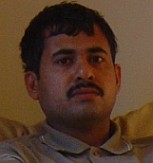

3 Comments:
Excellent! Keep Writing!
-Suraj
Nice post. And excellent pics! Now, I wish you cover other parts of South India as well!
good, make more
Post a Comment
<< Home